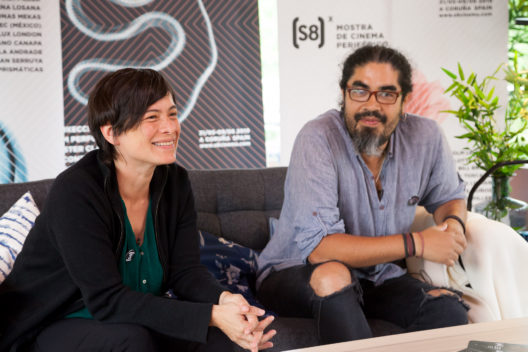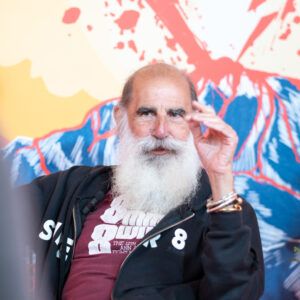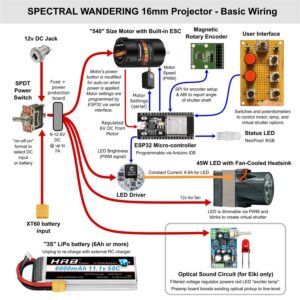
THE ORIGINS OF LEC
Morris Manuel Trujillo: LEC is an evolution of a project started by a group of friends, including myself, named La Trinchera Ensamble, which was created in 2003-2004. Back then, the people involved, and who became closer friends during this process –Azucena, Elena, Rafa, and myself– worked on that group project that was very collaborative: more than 150 artists participated during the three years it lasted. And after that, Elena and had this idea that it would be great to create a space that had more to do with the management of experimental cinema. It also came from an increased awareness of analogue cinema, experimental cinema, expanded cinema… and the importance of promoting them. This is where and how LEC starts: it’s an initiative that, from its very beginning, has approached cinema also from the perspectives of its management and dissemination –also from the point of view of learning, of sharing our knowledge with the participants, and learning from them, too. We wanted a place to host workshops, a dark room… A place that allowed us to develop this collaboration with other artists, with the many artists that might be interested in working with and on analogue film.
ART & ACTIVISM
Morris Manuel Trujillo: After we co-founded LEC, I got really involved in the management and production of moving image art. So, over the last years, I’ve been less productive when it comes to my own work as an artist, that’s true. But at the same time, my experience as a member of La Trinchera led me to conceive my work in terms of live performance, of expanded cinema. It’s been a long time since the last time I actually shot a short-film. My work now mainly relies on collaborating with other artists, musicians, sound artists, other filmmakers that are into expanded cinema, too… And that’s why most of my pieces are to be seen from a very specific point of view, which is the one I like –I want the viewers to confront my art live, during a performance. I’ve made lots of pieces in collaboration with Elena, thanks to the closeness between us that LEC has provided. But I’ve also made collaborative works with Azucena, and here at the S8 we’ll actually be presenting something that was co-authored by the three of us.
Elena Pardo: I would the say that this project, the LEC project, becomes an art project in itself. It’s true, sometimes we are led to think that we’ve been here for years, organizing film exhibitions and workshops for everyone, and we might feel that this is all we do now and what we’ll always do from now, because it’s a really demanding job. However, while there is some truth in this, it’s also true that the fact of having this place, of being involved in this huge collaborative project, becomes an art project itself. Having this community, being part of it, has led us to an incredible amount of places –it’s the very reason why we’re here today. Being a collective that is the result of many people, many artists’ contributions makes it alive, and allows it to go places.
THE PERFORMANCES
Elena Pardo: Desaparecer originated in an invitation to participate in Barcelona’s festival L’Alternativa. We did have an idea already, so that was the perfect excuse to put a deadline to it. It’s a project that has to do with a situation in Mexico now –the fact that we’re constantly confronted, in the media, to people disappearing in the country and never coming back. They’re never seen again. This is something that somehow has become part of the Mexico’s landscape, and it always happens in the same places: the mountains, the countryside… So we wanted to approach this subject, but not in a way that was too literal or evident. We wanted to discuss the idea of disappearing in an abstract way, like thinking about of disappearing into the space of the film, exploring the material aspects of it to discuss these events. With this in mind, we went to Oaxaca, to the north sierra, where it’s always very misty –you get the feeling that you’re there, and at the same time you’re lost. You can’t really tell where you are exactly. And what we wanted was to incorporate this mist and this feeling of being lost and confused, into our film. Also, from the beginning we collaborated with Fernando Vigueras, who is a Mexican musician and sound artist, and he was there for most of the presentations. When we travel, sometimes one of us cannot be present, so we find local artists that might be willing to do this, and we develop new collaborations.
Morris Manuel Trujillo: Love Machine originated in a collaboration with Azucena Losana last year in Rio de Jainero. After that, when we started to present it at the Labs’ meeting event in Ciudad de Mexico, Elena would first show one of her pieces, and then Azucena and I would do our part. And what has been touring the festivals is a kind of mashup of this. Now, for the first time, we’re going to present it here at S8 – the three of us together! If I have to describe it, I would say it’s a research on film lab’s history, on the analogue machines. It’s not really a documentary, but something totally experimental and that explores the fun aspects of those machines. That’s where the title Love Machine comes from. We wanted to create a different expression of the tools we work with. We reappropriated a number of images –some of them are animations– that are related with analogue film, and the history of film labs and their machines.
THE CHURUBUSCO PROJECT
Elena Pardo: It all started thanks to Naomi Uman. We already knew that the labs existed, all of us had, sometime in our lives, gone there for developing something or whatever. The Churubusco labs were founded in the 50s, and, for decades, that’s where Mexican films were produced, developed, and copied. The last years there hasn’t been a lot of film work, but the labs are managed by the State, so they don’t really need to close –which is the case of almost every other lab, as they are subject to the market’s needs. So the Churubusco lab is something that is always there, like a constant presence. So one day Naomi had to go there because she needed a machine, which they didn’t have. But she came back really excited and yelling that we really needed to do something there! We talked it over with some friends and went to Churubusco to propose the project of an art residency that would take place there. After many meetings and visits and conversations, they accepted, and we were allowed to have a space for us in the Churubusco facilities, a quite big space… so we made a call for artists among those we knew could be interested in that kind of residency. It consisted in going there and spending the time you needed for completing a project –you were free to choose your subject, your goals, and everything. And this produced an incredible array of works: fiction, documentary, experimental… everyone participated according to their own interests, in a way and for a duration of their choice.
Morris Manuel Trujillo: Yes. And, when it comes to this project, there was also this idea of reflecting on how the cinema industry is dying in Mexico, and the Churubusco lab was something like a ghost space where the workers didn’t really have anything else to do. So working with them, developing all these activities with them was one of our goals, too. Many of the projects had to do with bringing some life into the lab, bringing something to do to the workers –people who have an incredible amount of knowledge that doesn’t seem to be useful or valued anymore. And LEC really seemed to bring that kind of life to them, to the lab. It lasted only a few months, but you could see how many of those workers were moved and excited to see that people continued filming, that crazy people continued to use film. Because, to us, film is alive, but you could tell they really had this feeling that it was dying, that their knowledge was dying. So it was a lovely experience in that sense, too.





